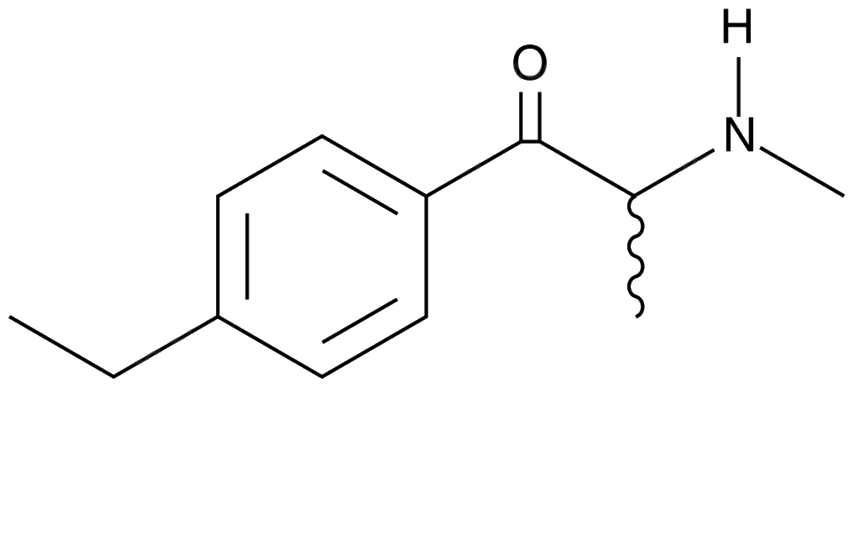Contents
- 1 Summary
- 2 Legal status
- 3 FAQ
- 3.1 1. What is 4-Ethylmethcathinone (4-EMC)?
- 3.2 2. Where has 4-EMC been identified?
- 3.3 3. What is the legal status of 4-EMC in the United States?
- 3.4 4. Is 4-EMC regulated in specific U.S. states?
- 3.5 5. What are the effects and risks associated with 4-EMC use?
- 3.6 6. Is 4-EMC used for any medical purposes?
- 4 References
Summary
4-Ethylmethcathinone (4-EMC) is categorized as a recreational designer drug in the stimulant and entactogen class. It shares its structural isomer status with 4-MEC and 3,4-DMMC. The presence of 4-EMC has been detected in numerous countries across the globe, with its initial identification occurring in Europe. Notably, it was first discovered in Australia in the year 2020.
| Identifiers | |
|---|---|
| IUPAC name | |
| CAS Number | 1225622-14-9 |
|---|---|
| PubChem CID | 71316576 |
| ChemSpider | 25630253 |
| UNII | 3I378P59DJ |
| Chemical and physical data | |
| Formula | C12H17NO |
| Molar mass | 191.274 g·mol−1 |

Legal status
In the United States, 4-EMC is classified as a Schedule 1 controlled substance due to its status as a positional isomer of 4-Methylethcathinone (4-MEC).
Furthermore, 4-Ethylmethcathinone has been designated a controlled substance in Vermont, USA, effective January 2016. Additionally, it falls under analog provisions in many other legal jurisdictions.
FAQ
1. What is 4-Ethylmethcathinone (4-EMC)?
- 4-Ethylmethcathinone, often referred to as 4-EMC, is a synthetic recreational drug. It belongs to the class of stimulants and entactogens and is structurally related to substances like 4-MEC and 3,4-DMMC.
2. Where has 4-EMC been identified?
- 4-EMC has been identified in various countries across the world. It was initially discovered in Europe and gained attention as a designer drug. Notably, it was first found in Australia in the year 2020.
3. What is the legal status of 4-EMC in the United States?
- In the United States, 4-EMC is classified as a Schedule 1 controlled substance. This classification is due to its status as a positional isomer of 4-Methylethcathinone (4-MEC).
4. Is 4-EMC regulated in specific U.S. states?
- Yes, 4-Ethylmethcathinone is considered a controlled substance in the U.S. state of Vermont as of January 2016. Additionally, it may be subject to analog provisions in other legal jurisdictions.
5. What are the effects and risks associated with 4-EMC use?
- The effects and risks of 4-EMC use may vary and are not well-documented due to limited scientific research. As with any designer drug, users should exercise caution, as unexpected effects and potential health risks can be associated with its consumption.
6. Is 4-EMC used for any medical purposes?
- 4-EMC does not have recognized medical applications. It is primarily encountered and used as a recreational substance.
The legal status and scientific understanding of 4-EMC may have evolved since my last update in September 2021. Stay informed about this compound’s latest developments and regulations if you have any concerns or interests in its use or research.
References
- Rickli A, Hoener MC, and Liechti ME conducted research in March 2015, focusing on “Monoamine transporter and receptor interaction profiles of novel psychoactive substances: para-halogenated amphetamines and pyrovalerone cathinones.” Their findings were published in the European Neuropsychopharmacology journal (Volume 25, Issue 3).
- Skultety L, Frycak P, Qiu C, Smuts J, Shear-Laude L, Lemr K, et al., in June 2017, published a study titled “Resolution of isomeric new designer stimulants using gas chromatography – Vacuum ultraviolet spectroscopy and theoretical computations.” This research was featured in the Analytica Chimica Acta journal (Volume 971).
- In October 2020, Bade R, Abbate V, Abdelaziz A, Nguyen L, Trobbiani S, Stockham P, Elliott S, White JM, and Gerber C delved into “The complexities associated with new psychoactive substances in influent wastewater: The case of 4-ethylmethcathinone.” Their findings were published in Drug Testing and Analysis (Volume 12, Issue 10).
- The U.S. Department of Justice released a document titled “Lists of: Scheduling Actions Controlled Substances Regulated Chemicals” in February 2023, providing insights into the scheduling of various substances, including controlled and regulated chemicals.
- The Vermont Department of Health published the “Regulated Drugs Rule” document, available in PDF format. This document outlines regulations related to controlled substances and was last accessed on October 5, 2016.